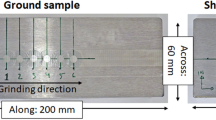Abstract
Magnetorheological abrasive flow finishing (MRAFF) was developed as a new precision finishing process for complicated geometries using smart magnetorheological polishing fluid. This process introduces determinism and in-process controllability of rheological behaviour of abrasive laden medium used for finishing intricate shapes. Magnetorheological polishing (MRP) fluid is comprised of carbonyl iron powder and silicon carbide abrasives dispersed in a viscoplastic base of grease and mineral oil and exhibits change in rheological behaviour in presence of external magnetic field. This smart behaviour of MRP fluid is utilized to precisely control finishing forces. The process performance in terms of surface roughness reduction depends on process variables like hydraulic extrusion pressure, magnetic flux density in the finishing zone, number of finishing cycles, and composition of MRP fluid. In the present work, experiments were conducted on a hydraulically powered MRAFF experimental setup to study the effect of extrusion pressure and number of finishing cycles on the change in surface roughness of stainless steel grounded workpieces. A new observation of “illusive polishing” action with the initial increase in number of finishing cycles is reported. The actual finishing action is possible only after removal of initial loosely held material remaining after grinding.
Similar content being viewed by others
References
Williams RE, Rajurkar KP, Rhodes LJ (1989) Performance characteristics of abrasive flow machining. SME Technical Paper FC89-806:695–706
Fox M, Agrawal K, Shinmura T, Komanduri R (1994) Magnetic abrasive finishing of rollers. CIRP Ann 43/1
Umehera N (1994) Magnetic fluid grinding - a new technique for finishing advanced ceramics. CIRP Ann 43/1:185–188
Kordonski WI, Jacobs SD (1996) Magnetorheological finishing. Int J Mod Phys B 10/23,24:2837–2848
Kordonski W, Golini D (1999) Progress update in magnetorheological finishing. Int J Mod Phys B 13/14,15,16:2205–2212
Jha Sunil, Jain VK (2004) Design and development of the magnetorheological abrasive flow finishing (MRAFF) process. Int J Mach Tools Manuf 44/10:1019–1029
Furst EM, Gast AP (2000) Micromechanics of magnetorheological suspensions. Phys Rev E 61/6:6732–6739
Ginder JM, Davis LC (1994) Shear stresses in magnetorheological fluids: role of magnetic saturation. Appl Phys Lett 65/26:3410–3412
Fang L, Zhou QD, Li YJ (1991) An explanation of the relation between wear and material hardness in three-body abrasion. Wear 151:313–321
Acknowledgements
We sincerely thank BASF Germany for arranging carbonyl iron powders of different grades for our research work. We acknowledge the Council of Scientific and Industrial Research, New Delhi, India for their financial support for project no. 5411/NS/02/EMR II entitled “Magnetorheological Abrasive Flow Finishing (MRAFF) Process”.
Author information
Authors and Affiliations
Corresponding author
Rights and permissions
About this article
Cite this article
Jha, S., Jain, V.K. & Komanduri, R. Effect of extrusion pressure and number of finishing cycles on surface roughness in magnetorheological abrasive flow finishing (MRAFF) process. Int J Adv Manuf Technol 33, 725–729 (2007). https://doi.org/10.1007/s00170-006-0502-x
Received:
Accepted:
Published:
Issue Date:
DOI: https://doi.org/10.1007/s00170-006-0502-x




